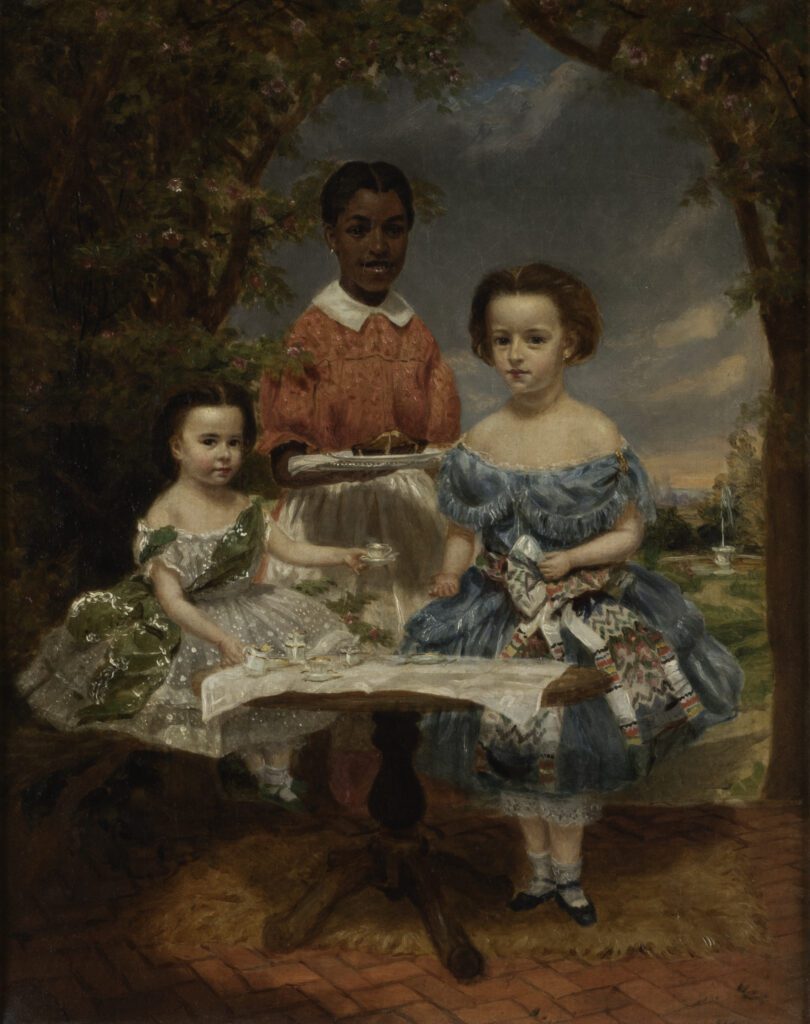WINTERTHUR, DE (May 4, 2024) – Winterthur Museum, Garden & Library has acquired an 1857 oil painting in remarkable condition depicting an identifiable free Black member of the regional Baltimore community.
In this group portrait, Vermont-born painter Thomas Waterman Wood (1823–1903) documented an important moment in history just before the American Civil War when the Baltimore area held the largest population of free Blacks in the United States, said Dr. Kedra Kearis, associate curator of art and visual culture at Winterthur.
The work was commissioned by Quaker abolitionists James Ellicott and Harriet Jolliffe Tyson and painted during Wood’s two-year tenure in Baltimore. The narrative-style portrait portrays servant Sidney Hall tending to the Tysons’ youngest children, Patty and Lilly, who are engaged in a tea party on an outdoor brick patio. At the time of the painting, Sidney was 22 years old, and Patty and Lilly were 5 and 3, respectively.

Rachel and Ben Elwes of Ben Elwes Fine Art, London, brokered the sale. Rachel Elwes is a graduate of the Winterthur/University of Delaware Program in American Material Culture.
“When Rachel presented this painting to me and then shared it with Kedra Kearis, we both knew this was an ideal acquisition for Winterthur,” said Alexandra Deutsch, John L. and Marjorie P. McGraw Director of Collections at Winterthur. “The layers of history this painting represents continue to unfold as the research expands.”
“By naming Sidney Hall and working to uncover and share her story, we have a tremendous opportunity to engage with the representation of a Black sitter and staff member of the abolitionist Tyson family,” Kearis elaborated. “The picture was painted about four years before the Civil War when enslavement remained legal in Maryland. The Baltimore area had approximately 25,000 free Black community members. It was amidst this complicated backdrop that Wood painted Sidney Hall’s portrait.”
The painting, measuring 17 ½ x 13 ½ inches, is on display in the Galleries at Winterthur starting Tuesday, May 7, 2024.
Dr. Joyce Hill Stoner, paintings conservator and Elizabeth Goodman Rosenberg professor of material culture and director of the preservation studies doctoral program at the University of Delaware, examined the painting and remarked on its close-to-original condition.
“It is rare to see a painting of this age with so little intervention,” Stoner said.
Two members of the Tyson family previously owned the painting. Its reverse side bears a stamp identifying a Baltimore canvas supplier.
The acquisition was unanimously approved by both Winterthur’s collections committee and executive committee, said Chris Strand, Charles F. Montgomery Director and CEO of Winterthur.
“There was a feeling of jubilation in the room when the final votes came in and we knew this remarkable painting would become part of Winterthur’s collection,” Strand said.
“For those of us who advocated for this acquisition, it was an inspiring moment to see the support the trustees offered for this purchase,” Deutsch added. “I knew the history of the Tyson family and the history of Baltimore’s large free Black population before the Civil War. As I looked beyond the quality of the painting, I immediately saw the interpretive potential it offered as a document of Black history and the history of abolition.
“This acquisition attests to Winterthur’s commitment to building its collection with an eye to objects that allow us to further tell complete histories. It is a fine painting in remarkable condition. Still, it is also an important historical document of Sidney Hall, a free Black woman in the Baltimore area, and the Tyson family’s association with the abolition movement.”
The composition’s background evokes the rolling hills of Ellicott Mills, now Ellicott City, about ten miles west of Baltimore. Cofounded in the early 1770s by surveyor Andrew Ellicott and his brothers, Ellicott Mills became the site of the Tyson flour mills headed by Pennsylvania-born Quaker and abolitionist Elisha Tyson. Tyson used his wealth to support the Underground Railroad and the African colonization movement.
Martha Ellicott Tyson, grandmother to Lilly and Patty, was an advocate for women’s higher education and co-founder of Swarthmore College, as well as author of A Sketch in the Life of Benjamin Banneker; from Notes Taken in 1836 (1854). A neighbor and friend of the Ellicotts, Banneker was a free Black tobacco farmer, mathematician, and astronomer who contributed to the survey that defined the boundaries of the country’s capital.
The painting adds to Winterthur’s collection of works by Thomas Waterman Wood, Kearis said.
“Wood, through his genre paintings and narrative portraits, represents an important figure in 19th-century art, dedicated to portraying a range of individuals across the swiftly changing political landscape of the United States,” Kearis said.
Images of the painting can be downloaded here.
ABOUT WINTERTHUR MUSEUM, GARDEN & LIBRARY
Winterthur—known worldwide for its preeminent collection of American decorative arts, naturalistic garden, and research library for the study of American art and material culture— offers a variety of tours, exhibitions, programs, and activities throughout the year.
Winterthur is located on Route 52, six miles northwest of Wilmington, Delaware, and five miles south of U.S. Route 1. Winterthur is committed to accessible programming for all. For information, including special services, call 800.448.3883 or visit winterthur.org.